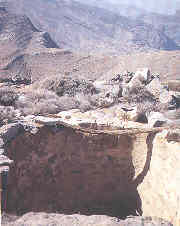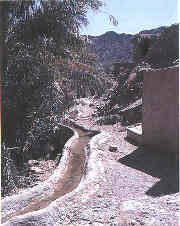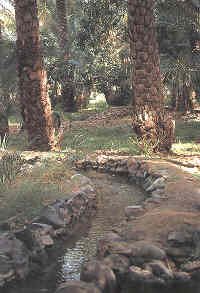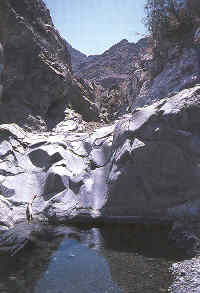|
In a country with very little
rainfall the distribution of water for agricultural or
domestic purposes is matter of great importance.
Originally people settled where the water was around
wells and springs. These are fed by subterranean water
that has collected in the ground in those places where
impermeable layers prevents it from sinking deeper. This
water is relatively close to the surface and can dry up
during periods of drought.
An
old method for bringing the water from a deep well to
the surface to use for irrigation was practiced on the
east coast and in Ras al Khaymah until recently.
A ramp was built,
sloping down away from the well. A bull was then trained
to walk down the ramp, pulling a rope across a pulley.
The rope was attached to a goat-skin bag. As the bull
walked down the ramp, the water was drawn up and then
tipped into a trough that fed the irrigation channels
leading to the fields. When the bag was empty, the bull
was turned around and walked back up the ramp, lowering
the bag into the well. This process would be repeated
for hours on end.
Sometimes the
soil around a spring or well would not be very suitable
for agriculture. Fertile land would be further away and
therefore people began to think of ways in which water
could be brought over long distances to their fields.
The mountains
have larger supplies of water, with permanent pools or
aquifers (seams in the rock that bring water to the
surface) in many places. Thousands of years ago
ingenuous people learned how to bring this water from
the mountains to their fields, sometimes over great
distances. No bulls were needed for this process, for
they used the power of gravity.
The falaj-system
consisted of a mother well, a system of tunnels that
sloped down from the mother well to the surface lower
down the mountains, a sharia a container or
pond where the water was collected, and a series of
irrigation channels or aflaj (plural of falaj)
that led the water to those sites where it was needed.
These last channels were often partly covered with big
slabs of rock, to protect the water.
The process of
building this system was started by finding the mother
well the source of permanent water in the mountains.
Often it was a surface pond or spring, sometimes a well
had to be dug to reach the water source. Then the point
at which the water had to emerge from the mountain near
the fields was determined and the slope of the tunnels
that had to be dug was calculated. This slope depended
of course on the location of the mother well and the
distance over which the water had to be transported. It
had to have a gradient of anywhere between 1/500 to
1/2500; the smaller the gradient, the slower the speed
of the water. Slow speed was necessary so that the water
would not erode the tunnel and cause tunnel collapses.
The digging of the tunnels was usually started at the
lower end, sometimes at both ends at the same time. A
ventilation shaft to the surface was dug every 20
meters, or so. This shaft also served as access to the
tunnels for cleaning and maintenance of the system. The
rim of the shaft was heightened by a rim of stones and
baked clay to prevent debris being deposited into the
tunnels by water runoff during rains. Recently some old
ventilation shafts in a wadi near Al Ain were provided
with cement rims, which are more durable but not quite
as picturesque as the old ones. The tunnels were just as
wide as a man. Sometimes, small boys used to go down the
ventilation shafts for cleaning jobs, as they were more
comfortable in the confined space. However, if the
fathers thought there was a significant risk, they would
go themselves to do this job. The underground channels
stretched over many kilometers. The oasis of Al Ain
depended on such a falaj-system that brought water all
the way from the Hajar Mountains, some 20 kms away. Once
the main tunnel was completed, side tunnels were
sometimes made into the area around the mother well in
order to enlarge the drainage area and increase the flow
of water.


Until recently it
was thought that the falaj-system originated in Persia,
where it is called qanat or karez. Most of
the qanats were found in Iran, around the extensive
plateau, which forms central Iran. There are also qanats
in western China (the beautiful city of Turfan depends
on qanats for its water), Afghanistan and on the North
African continent, from Lybia and Algeria to Morocco.
The Romans introduced the idea to Egypt and Syria where
the tunnels were built by slaves. As soon as the supply
of slave labour dried up, so did the tunnels; without
regular maintenance they clogged up in no time.
Quite recently
solid evidence has been provided that the falaj-system
that was used in Arabia preceded the first use of qanats
in Persia. Archeaolgical discoveries in Hili and Qarn
bin Saud near Al Ain have shown that the system was in
use 3000 years ago. Covered tunnels and sharias were
laid bare, quite deep under the present surface of the
desert. Pottery shards found in and near the sharia were
carbon-dated to the Iron Age, 1000 BC. Dr Walid al-Tikriti,
who has done archeological work for some 30 years in the
Al Ain area, wrote about this discovery in a recently
published book. Since the publication of the first work,
more evidence has been found to support the premise that
the idea of the underground water channels was an
Arabian one.
The falaj-system
is clever in many ways. First, because gravity is used
to bring the water to the place where it is needed,
there is no machinery involved that is costly and can
break down.
Secondly, by
keeping the water underground for most of its journey,
evaporation and pollution are kept to a minimum.
Thirdly, the system allows for a judicious division of
available water to all the people who need it.
The water was put
into multiple use. Where the water entered the sharia it
was used for drinking. Then came the bathing areas,
usually constructed separately for men and women.
Channels then ran through mosques and forts to provide
water there, eventually reaching the mughisla
where the dead were washed. Finally the water emerged
into the gardens. Here the water was divided by means of
a complex share-holding system of rotation and
time-allocation. The period of time during which a
person could irrigate his fields was measured by the
increase in the length of a mans shadow or at night by
the movement of the stars. The amount of water also
depended on the type of soil. The finer the soil, the
longer the cycle.
There is also
deep underground water in the non-mountainous areas of
the country. These deeper layers of water can be brought
to the surface by artesian wells or by pumping. This
fossil water, as it is called, is not inexhaustible. Its
recharge takes place over many centuries, if at all. In
the UAE it has been used extensively during the last
decades of incredible expansion in the UAE and it will
soon no longer be available.
One way to
increase the amount of accessible water is to prevent
its run-off during rains. For this purpose dams have
been built across water streams ever since man began
settling and tilling the land. Lately in the UAE, dam
building in the mountains has been undertaken on a grand
scale in order to meet the ever-increasing demands of
the local population. This water is mainly used to
replenish the ground water by preventing rainwater to
flow out into the sea. The manmade lakes that are the
result of the damming have become popular recreation
spots, such as the lakes at Hatta, in wadi Shii near
Khor Fakkan, wadi Bih and wadi Zikt.
In the coastal
areas the water that is used for irrigation partly comes
from desalination of sea water (the main source of water
used nowadays) and partly from treated sewage. This
latter source of irrigation water could be increased by
introducing a method that has been tried and proven
abroad: sewage ponds for collecting sewage combined with
reed beds in which this fluid is purified. The water
produced in this way is even suitable for drinking, but
is usually used to water gardens and parks. In the UAE
the system could be installed in every project where a
lot of sewage is produced, such as hospitals, hotels,
villa compounds, and schools. Apart from being
inexpensive there is the added advantage that the reed
beds provide greenery and attract birds. As long as the
water is being circulated at a sufficient rate there
would have to be no need to fear the occurrence of
harmful insects such as mosquitoes that only breed on
standing water.
In the mountains
deep cisterns used to be cut into the ground and lined
with rocks to hold rainwater for domestic use. Some of
it may have been used to irrigate fields but there is
not much evidence of this, such as channels running from
the cistern to the fields. In any case, the water in the
cistern would have been barely enough for drinking and
washing during the dry season and would not have been
enough to make a difference to the crops.


The huge
afforestation projects along the edge of the Rub al
Khali (Liwa) in Abu Dhabi emirate are irrigated mainly
by drip irrigation with desalinated water, brought down
from the coast. Many of the dunes there have been
flattened by bulldozers to be turned into agricultural
fields. They are often watered by water cannons a
method in which much water is lost through evaporation,
especially in our dry desert climate. Water cannons are
also in use on agricultural fields near Ras al Khaymah.
A similar system near Dubai uses treated water from the
nearby sewage plant. These fields are favourite foraging
places for migrating and resident birds and are visited
every weekend by birding enthusiasts.
Water is the true
elixir of life and there are predictions that the world
will run out of usable water before the end of this
century. Methods of water conservation should become
taught at all schools and should be the subject of TV
spots to teach adults. There are many ways in which even
one individual can contribute to saving water that is
needed for drinking, bathing and growing the food we
need. | 